The Dry Laundry Detergent Market is currently characterized by a dynamic competitive landscape, driven by innovation, sustainability, and consumer preferences for eco-friendly products. Major players such as Procter & Gamble (US), Unilever (GB), and Henkel (DE) are actively shaping the market through strategic initiatives that emphasize product differentiation and environmental responsibility. Procter & Gamble (US) has focused on enhancing its product portfolio with advanced formulations that cater to specific consumer needs, while Unilever (GB) has been investing in sustainable sourcing and packaging solutions to align with growing environmental concerns. Henkel (DE), on the other hand, has been leveraging its strong brand equity to expand its market presence in emerging economies, thereby enhancing its competitive positioning.
The business tactics employed by these companies reflect a concerted effort to optimize supply chains and localize manufacturing processes. The Dry Laundry Detergent Market appears moderately fragmented, with a mix of established brands and emerging players vying for market share. The collective influence of key players is significant, as they not only set industry standards but also drive innovation through competitive practices that encourage sustainability and efficiency.
In August 2025, Unilever (GB) announced a partnership with a leading technology firm to develop AI-driven solutions for optimizing its supply chain. This strategic move is likely to enhance operational efficiency and reduce costs, positioning Unilever to respond more effectively to market fluctuations and consumer demands. The integration of AI into supply chain management could also facilitate better inventory control and demand forecasting, thereby improving overall service levels.
In September 2025, Procter & Gamble (US) launched a new line of concentrated laundry detergents that utilize biodegradable ingredients. This initiative not only addresses consumer preferences for environmentally friendly products but also aligns with the company's broader sustainability goals. By focusing on concentrated formulations, Procter & Gamble (US) aims to reduce packaging waste and transportation emissions, which could resonate well with eco-conscious consumers.
In July 2025, Henkel (DE) expanded its product offerings in the Asian market by introducing a new range of laundry detergents specifically designed for cold water washing. This strategic expansion reflects Henkel's commitment to catering to regional preferences and optimizing energy consumption, which is increasingly important in markets where energy costs are rising. By tailoring products to local needs, Henkel (DE) strengthens its competitive edge in a diverse marketplace.
As of October 2025, the competitive trends in the Dry Laundry Detergent Market are increasingly defined by digitalization, sustainability, and the integration of advanced technologies. Strategic alliances are becoming more prevalent, as companies seek to enhance their capabilities and market reach. The shift from price-based competition to a focus on innovation, technology, and supply chain reliability is evident, suggesting that future competitive differentiation will hinge on the ability to adapt to evolving consumer expectations and environmental standards.


















Leave a Comment